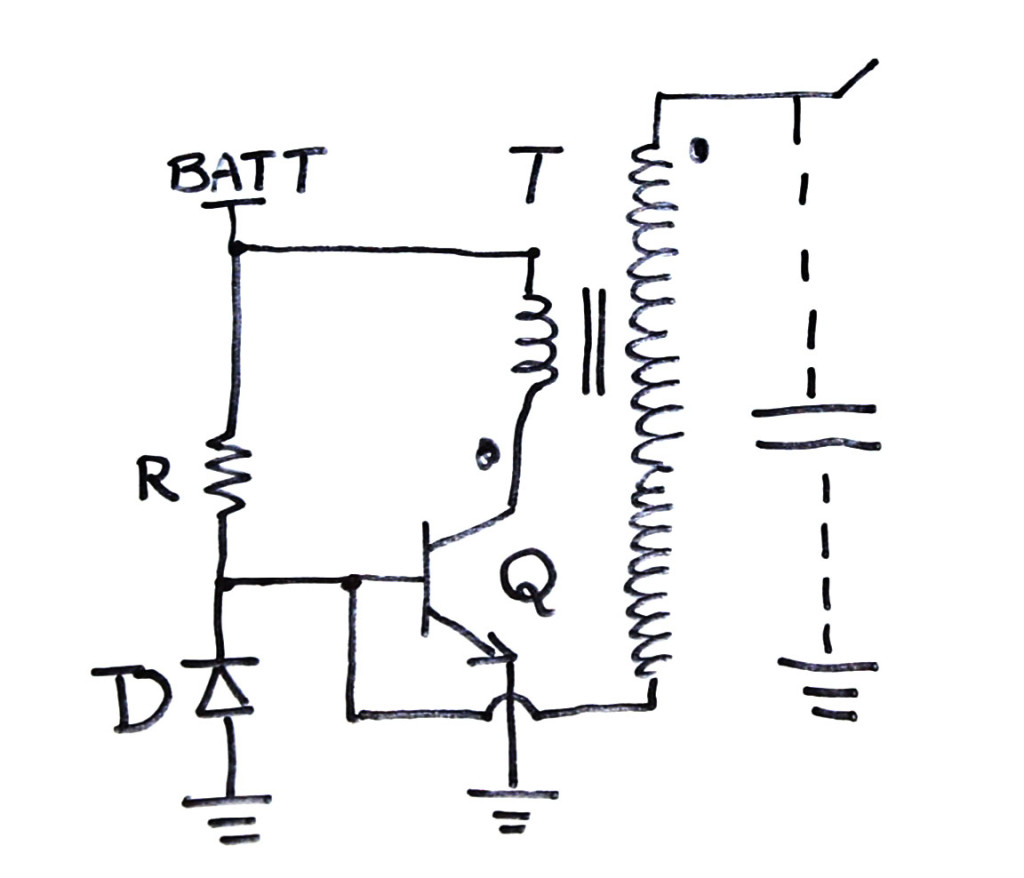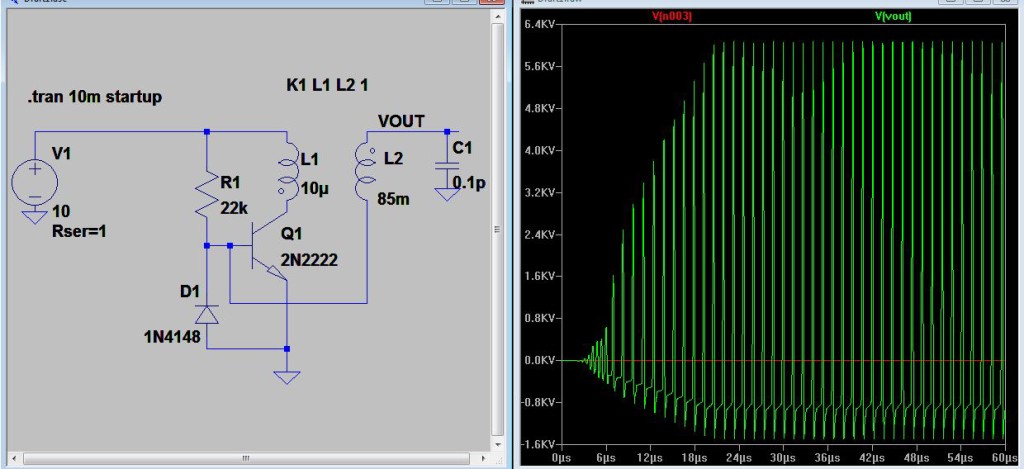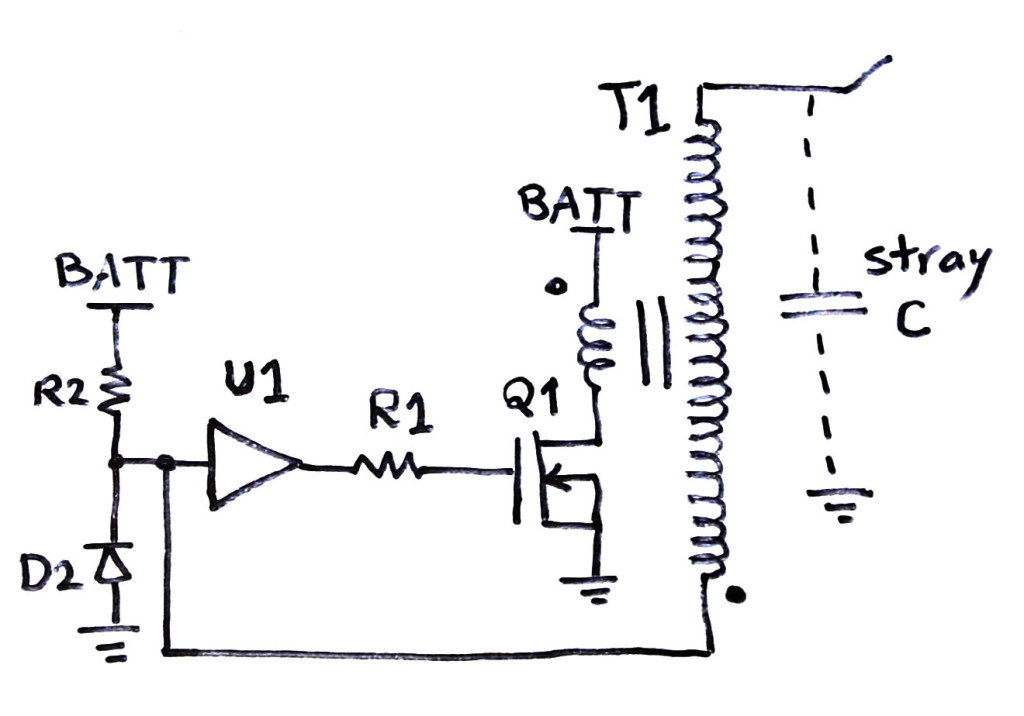Does this so called slayer exciter work?
Well I guess it does! I was initially pretty confused about the circuit, but after finding out that there is this parasitic capacitance on the output of the secondary winding, all became clear and now I’m in love with this circuit!
Let me explain how it works. Below is the picture of the circuit. This circuit is the simplest thing that can generate such high voltage I’ve ever seen, so I love it! I also added the missing information in the circuit:
- The stray or parasitic capacitance that exists on the output of the secondary winding. You don’t add it, but the capacitor exists naturally there. Also in case of a Tesla coil the toroid on the top helps with creating this capacitance.
- The way the transformer needs to be connected, by showing those transformer dots.
 The components I used are as follows:
The components I used are as follows:
- Q: 2N2222, or 2N5550 or similar regular NPN with >50V VCE and >60 hfe
- D: 1N4148, or 1N400x (x is a number)
- R: >= 22kOhm
- T: my hand made transformer I showed in the video. With primary of 10 turns (could be fewer depending on where you connect the wires) and secondary of around 750 turns.
You might want to watch the video which inspired me here to see how Ludic Science made his own. You can add more transistors and reduce R to make the circuit drive stronger.
Now, this circuit works like this:
- Turning the circuit on, R drives the base of the transistor Q
- Q turns on and drives current into the primary of the transformer. The current is limited by the limited available base current.
- The created magnetic field drives the secondary of the transformer.
- The secondary voltage wants to grows large. But the tiny stray capacitance on the output resists the change, although very small, against the rise of the output end and so in return the voltage on the other end of the transformer goes down, pulling the base of the transistor low.
- Diode D prevents the base voltage to fall more than 0.7V below ground, which in return pushes the output end of the secondary high.
- The transistor turns off and so the magnetic field starts to reduce.
- The base voltage rises again and Q turns on and the cycle repeats.
I was able to simulate this in LTSPICE as shown in the figure below, of course the simulation result is a very rough estimation of the truth as I didn’t exactly know the transformer properties or the output capacitance value.
There are a few things I learned in the process, such as the fact that it is very important for the oscillation frequency to be exactly at the output tank circuit (L-C) frequency for maximum power output. The greatness of the Slayer Exciter is that it makes the circuit oscillate exactly at that frequency.
But I tried to use a function generator instead to excite the circuit which is another option. I found it quite tough to tune the frequency to the exact resonance of the coil, something that the Slayer does automatically. Especially with my low grade generator, when I was getting close to the target frequency, it would jump over it to the other side. It was like trying to balance a ball on a peak. The generator couldn’t hold the frequency there, I suspect because of radiation from the coil effecting the generator.
So after the success of the initial circuit, I put together the following circuit to boost the output. It is the exact same concept, just that instead I used a high power MOSFET transistor and a gate driver IC to drive the MOSFET. Note that for example for my transformer which resonates at 1MHz, it is crucial that the components can work at such frequency. If they can’t handle the oscillation frequency the circuit won’t oscillate.
Here are the part numbers I used:
- R1 = 2 Ohm
- R2 >= 22kOhm
- D2 = 1N4148, or 1N400x (x is a number)
- U1 = MIC4452 (MIC4452YN is the through-hole version)
- Q1 = 2SK2542 (This is an obsolete part. You can replace it with similar N-CH, >=500V, RDSon<2Ohm, >40W power)
I was initially worried that the low RDSon of the transistor would result in excessive current draw and overheat the transistor. But the amazing thing about the circuit is that when the circuit is oscillating at the resonance frequency of the transformer, the impedance is at its peak (1/(2 x Pi x (SQRT(L x C) where L is the output inductance and C is the stray capacitance) and so the current draw is at its minimum which is much smaller than supply voltage divided by the RDSon of the transistor.
For example in my case, depending on the number of primary turns, the current draw could be between 0.2A to 0.8A. This boosted circuit worked very well and I was able to run the primary at a single turn which provided the maximum output voltage, but probably not the best efficiency.
In any case, I love this circuit! But beware that such high voltage – high frequency signal can be hazardous. The frequency is not super high but still the energy is large.
Also something I noticed was that when I was close to the coil, my body would pick up the energy so much that if I touched any other metal object in the room, I would burn my finger! So we should keep a proper distance to this beast!


